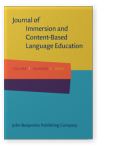Vol. 7:1 (2019) ► pp.115–141
Vol. 7:1 (2019) ► pp.115–141
EMI teacher and student identities and linguistic practices
Tracing classroom tensions in a teacher development process
Although the incorporation of English Medium Instruction (EMI) in multilingual higher education institutions is widely accepted, it may be a source of tension for university professors for whom English is an additional language, particularly when both teacher and students share an L1 other than English. A need exists to examine how linguistic attributes of EMI are interpreted and executed by participants. This study focuses on dialogue between a content specialist and a language specialist during an EMI teacher development partnership at a multilingual Catalan university. Membership Category Analysis (MCA) explores the categories made relevant in interaction, category associated features and responsibilities, and their procedural relevance within the interaction. The article focuses on results relating to the emerging identities of EMI classroom participants and related linguistic attributes. The results shed light on tensions relating to language use in EMI, and may inform EMI teacher development processes and classroom language policy.
Article outline
- 1.Introduction
- 2.EMI in the Spanish higher education context
- 3.Research on EMI teacher development in Spain
- 4.Context of study
- 4.1Instruction in English at university: Approaches and terminology
- 4.2Multilingual higher education: Policies and user preferences
- 4.3Membership category analysis for understanding interdisciplinary collaboration
- 5.Methodology
- 5.1Research aims and questions
- 5.2The context of the study
- 5.3Development partnerships for EMI
- 5.4Data collection and analysis
- 6.Results
- 6.1The category of EMI student
- 6.2The category of EMI instructor
- 6.3The category of ‘not a native speaker’
- 7.Discussion and conclusions
- Acknowledgements
- Note
-
References
